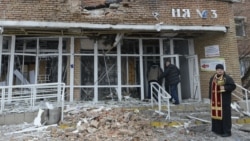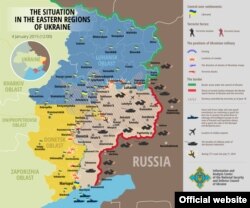From RFE/RL's News Desk:
The self-proclaimed pro-Russian separatist authorities in the area of the Ukrainian city of Donetsk have reimposed a curfew that had been temporarily lifted over the New Year's holiday.
The pro-separatist Donetsk News Agency reported on January 4 that "all legal and semi-legal entertainment establishments" must be closed by 10 p.m. Anyone found on the street after that time in a drunken state or without documents is subject to detention, the agency said.
The curfew had been lifted for the period from December 31 to January 3 to mark the New Year's holiday.
Also on January 4, the separatist "human rights commissioner" Darya Morozova said the separatists are conducting negotiations with the Ukrainian authorities on arranging a possible prisoner swap.
Morozova said the separatists are holding about 30 Ukrainian service personnel, and added that she estimated Ukrainian forces are holding about 220 people from the self-proclaimed Donetsk People's Republic.
On December 26, the two sides exchanged 149 Ukrainian service personnel for 222 detained people from the separatist areas.
Here is today's situation map of eastern Ukraine by the National Security and Defense Council:
From RFE/RL's News Desk:
Ukrainian President Petro Poroshenko has ordered his government to step up efforts to secure the release of service personnel captured by pro-Russian separatists in eastern Ukraine.
Poroshenko held a meeting with top security officials in Kyiv on January 4, according to a statement posted on the presidential website.
The officials also discussed measures to secure the country's borders and to improve the fighting capability of the Ukrainian military.
National Security Council head Oleksandr Turchynov said it will only be possible to cross the military control line around the zone where the government is fighting against separatist forces at seven designated crossing points.
Officials also announced that 100 "pieces of heavy equipment" will be handed over to the military on January 5.
"In only about one month we transferred to our military significant amounts of new or modernized military equipment," Poroshenko was quoted as saying.
More from The New York Times on the Ukraine crisis and what led to Yanukovych's swift fall last February. The article is by Andrew Higgins and Andrew E. Kramer and it is headlined "Ukraine Leader Was Defeated Even Before He Was Ousted." Might make good reading for Oliver Stone this weekend.
KIEV, Ukraine — Ashen-faced after a sleepless night of marathon negotiations, Viktor F. Yanukovych hesitated, shaking his pen above the text placed before him in the chandeliered hall. Then, under the unsmiling gaze of European diplomats and his political enemies, the beleaguered Ukrainian president scrawled his signature, sealing a deal that he believed would keep him in power, at least for a few more months.
But even as Mr. Yanukovych sat down with his political foes at the presidential administration building on the afternoon of Friday, Feb. 21, his last authority was fast draining away. In a flurry of frantic calls to opposition lawmakers, police and security commanders were making clear that they were more worried about their own safety than protecting Mr. Yanukovych and his government.
By that evening, he was gone, evacuated from the capital by helicopter, setting the stage for the most severe bout of East-West tensions since the Cold War.
Russia has attributed Mr. Yanukovych’s ouster to what it portrays as a violent, “neo-fascist” coup supported and even choreographed by the West and dressed up as a popular uprising. The Kremlin has cited this assertion, along with historical ties, as the main justification for its annexation of Crimea in March and its subsequent support for an armed revolt by pro-Russian separatists in Ukraine’s industrial heartland in the east.
Few outside the Russian propaganda bubble ever seriously entertained the Kremlin’s line. But almost a year after the fall of Mr. Yanukovych’s government, questions remain about how and why it collapsed so quickly and completely.
An investigation by The New York Times into the final hours of Mr. Yanukovych’s rule — based on interviews with prominent players, including former commanders of the Berkut riot police and other security units, telephone records and other documents — shows that the president was not so much overthrown as cast adrift by his own allies, and that Western officials were just as surprised by the meltdown as anyone else.
Read the full story here.
An excerpt from "The Next Battle For Ukraine" by Sabrina Tavernise in The New York Times:
Can a group of young reformers fix a broken country?
That is the question that Dmytro Shymkiv, the first deputy head of Ukraine’s presidential administration, is getting a lot these days. About a year ago, Mr. Shymkiv was running Microsoft in Ukraine and pondering accepting a promotion to the company’s offices in Latin America.
But history intervened. A mass protest movement toppled Ukraine’s government last February, precipitating some of the most momentous events of Ukraine’s post-Soviet life: a rethinking of its national identity, a war with Russia and the effective loss of control over a slice of eastern territory.
Now Mr. Shymkiv, 39, is helping to steer reform in Ukraine, a task that on some days seems exhilarating, and on others impossible.
“If you told me a year ago that I would be in the government, I would have said you are out of your mind,” Mr. Shymkiv said by telephone last month from his office in Kiev. “I’m working in an international corporation with great career development prospects and I’m going to do what?”
Read the full story here.






